Grant, Ulysses S.
president of United States
Introduction
original name Hiram Ulysses Grant
born April 27, 1822, Point Pleasant, Ohio, U.S.
died July 23, 1885, Mount McGregor, New York
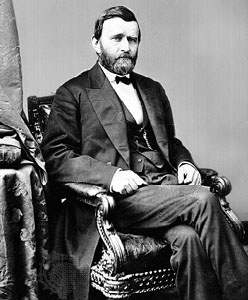 U.S. general, commander of the Union armies during the late years (1864–65) of the American Civil War, and 18th president of the United States (1869–77). (For a discussion of the history and nature of the presidency, see presidency of the United States of America.)
U.S. general, commander of the Union armies during the late years (1864–65) of the American Civil War, and 18th president of the United States (1869–77). (For a discussion of the history and nature of the presidency, see presidency of the United States of America.)Early life
Grant was the son of Jesse Root Grant, a tanner, and Hannah Simpson, and he grew up in Georgetown, Ohio. Detesting the work around the family tannery, Ulysses instead performed his share of chores on farmland owned by his father and developed considerable skill in handling horses. In 1839 Jesse secured for Ulysses an appointment to the United States Military Academy at West Point, New York, and pressured him to attend. Although he had no interest in military life, Ulysses accepted the appointment, realizing that the alternative was no further education. Grant decided to reverse his given names and enroll at the academy as Ulysses Hiram (probably to avoid having the acronym HUG embroidered on his clothing); however, his congressional appointment was erroneously made in the name Ulysses S. Grant, the name he eventually accepted, maintaining that the middle initial stood for nothing. He came to be known as U.S. Grant—Uncle Sam Grant—and his classmates called him Sam. Standing only a little over five-feet tall when he entered the academy, he grew more than six inches in the next four years. Most observers thought his slouching gait and sloppiness in dress did not conform with usual soldierly bearing.
Grant ranked 21st in a class of 39 when he graduated from West Point in 1843, but he had distinguished himself in horsemanship and showed such considerable ability in mathematics that he imagined himself as a teacher of the subject at the academy. Bored by the military curriculum, he took great interest in the required art courses and spent much leisure time reading classic novels. Upon graduation Grant was assigned as a brevet second lieutenant to the 4th U.S. Infantry, stationed near St. Louis, Missouri, where he fell in love with and married Julia Boggs Dent, the sister of his roommate at West Point.
In the Mexican War (Mexican-American War) (1846–48) Grant showed gallantry in campaigns under General Zachary Taylor (Taylor, Zachary). He was then transferred to General Winfield Scott (Scott, Winfield)'s army, where he first served as regimental quartermaster and commissary. Although his service in these posts gave him an invaluable knowledge of army supply, it did nothing to satiate his hunger for action. Grant subsequently distinguished himself in battle in September 1847, earning brevet commissions as first lieutenant and captain, though his permanent rank was first lieutenant. Despite his heroism, Grant wrote years later: “I do not think there was ever a more wicked war….I thought so at the time…only I had not moral courage enough to resign.”
On July 5, 1852, when the 4th Infantry sailed from New York for the Pacific coast, Grant left his growing family (two sons had been born) behind. Assigned to Fort Vancouver, Oregon Territory (later Washington state), he attempted to supplement his army pay with ultimately unsuccessful business ventures and was unable to reunite his family. A promotion to captain in August 1853 brought an assignment to Fort Humboldt, California, a dreary post with an unpleasant commanding officer. On April 11, 1854, Grant resigned from the army. Whether this decision was influenced in any way by Grant's fondness for alcohol, which he reportedly drank often during his lonely years on the Pacific coast, remains open to conjecture.
Settling at White Haven, the Dents' estate in Missouri, Grant began to farm 80 acres (30 hectares) given to Julia by her father. This farming venture was a failure, as was a real estate partnership in St. Louis in 1859. The next year Grant joined the leather goods business owned by his father and operated by his brothers in Galena, Illinois.
The Civil War (American Civil War)
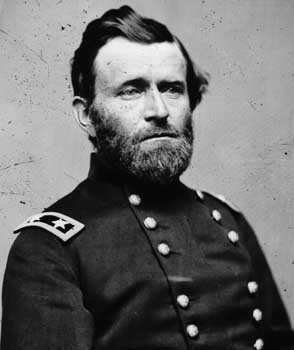 At the outbreak of the Civil War (American Civil War) in April 1861, Grant helped recruit, equip, and drill troops in Galena, then accompanied them to the state capital, Springfield, where Governor Richard Yates made him an aide and assigned him to the state adjutant general's office. Yates appointed him colonel of an unruly regiment (later named the 21st Illinois Volunteers) in June 1861. Before he had even engaged the enemy, Grant was appointed brigadier general through the influence of Elihu B. Washburne, a U.S. congressman from Galena. On learning this news and recalling his son's previous failures, his father said, “Be careful, Ulyss, you are a general now—it's a good job, don't lose it!” To the contrary, Grant soon gained command of the District of Southeast Missouri, headquartered at Cairo, Illinois.
At the outbreak of the Civil War (American Civil War) in April 1861, Grant helped recruit, equip, and drill troops in Galena, then accompanied them to the state capital, Springfield, where Governor Richard Yates made him an aide and assigned him to the state adjutant general's office. Yates appointed him colonel of an unruly regiment (later named the 21st Illinois Volunteers) in June 1861. Before he had even engaged the enemy, Grant was appointed brigadier general through the influence of Elihu B. Washburne, a U.S. congressman from Galena. On learning this news and recalling his son's previous failures, his father said, “Be careful, Ulyss, you are a general now—it's a good job, don't lose it!” To the contrary, Grant soon gained command of the District of Southeast Missouri, headquartered at Cairo, Illinois.In January 1862, dissatisfied with the use of his force for defensive and diversionary purposes, Grant received permission from General Henry Wager Halleck (Halleck, Henry W) to begin an offensive campaign. On February 16 he won the first major Union victory of the war, when Fort Donelson (Fort Donelson, Battle of), on the Cumberland River in Tennessee, surrendered with about 15,000 troops. When the garrison's commander, General Simon B. Buckner (Buckner, Simon Bolivar), requested his Union counterpart's terms for surrender, Grant replied, “No terms except unconditional surrender can be accepted. I propose to move immediately upon your works.” For many, from that point on Grant's initials would stand for “unconditional surrender.”
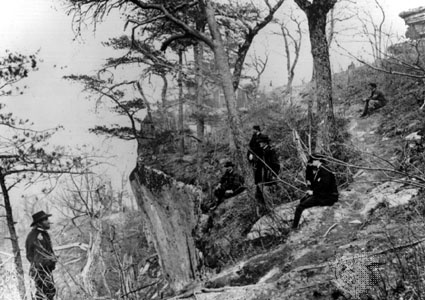 Promoted to major general, Grant repelled an unexpected Confederate attack on April 6–7 at Shiloh (Shiloh, Battle of) Church, near Pittsburg Landing, Tennessee, but the public outcry over heavy Union losses in the battle damaged Grant's reputation, and Halleck took personal command of the army. However, when Halleck was called to Washington as general in chief in July, Grant regained command. Before the end of the year, he began his advance toward Vicksburg (Vicksburg Campaign), Mississippi, the last major Confederate stronghold on the Mississippi River. Displaying his characteristic aggressiveness, resilience, independence, and determination, Grant brought about the besieged city's surrender on July 4, 1863. When Port Hudson, Louisiana, the last post on the Mississippi, fell a few days later, the Confederacy was cut in half.
Promoted to major general, Grant repelled an unexpected Confederate attack on April 6–7 at Shiloh (Shiloh, Battle of) Church, near Pittsburg Landing, Tennessee, but the public outcry over heavy Union losses in the battle damaged Grant's reputation, and Halleck took personal command of the army. However, when Halleck was called to Washington as general in chief in July, Grant regained command. Before the end of the year, he began his advance toward Vicksburg (Vicksburg Campaign), Mississippi, the last major Confederate stronghold on the Mississippi River. Displaying his characteristic aggressiveness, resilience, independence, and determination, Grant brought about the besieged city's surrender on July 4, 1863. When Port Hudson, Louisiana, the last post on the Mississippi, fell a few days later, the Confederacy was cut in half.Command over Union armies
 Grant was appointed lieutenant general in March 1864 and was entrusted with command of all the U.S. armies. His basic plan for the 1864 campaign was to immobilize the army of General Robert E. Lee (Lee, Robert E.) near the Confederate capital at Richmond, Virginia, while General William Tecumseh Sherman (Sherman, William Tecumseh) led the western Union army southward through Georgia. (See primary source document: Letters to W.T. Sherman Outlining Strategy for Spring 1864 (U.S. Grant: Letters to W.T. Sherman).) It worked. By mid-June, Lee was pinned down at Petersburg (Petersburg Campaign), near Richmond, while Sherman's army cut and rampaged through Georgia and cavalry forces under General Philip Sheridan (Sheridan, Philip H.) destroyed railroads and supplies in Virginia. On April 2, 1865, Lee was forced to abandon his Petersburg defensive line, and the surrender of Lee's army followed on April 9 at Appomattox Court House. This surrender, in effect, marked the end of the Civil War. The South's defeat saddened Grant. As he wrote in his Personal Memoirs, he felt “sad and depressed…at the downfall of a foe who had fought so long and valiantly, and had suffered so much for a cause, though that cause was, I believe, one of the worst for which a people ever fought.”
Grant was appointed lieutenant general in March 1864 and was entrusted with command of all the U.S. armies. His basic plan for the 1864 campaign was to immobilize the army of General Robert E. Lee (Lee, Robert E.) near the Confederate capital at Richmond, Virginia, while General William Tecumseh Sherman (Sherman, William Tecumseh) led the western Union army southward through Georgia. (See primary source document: Letters to W.T. Sherman Outlining Strategy for Spring 1864 (U.S. Grant: Letters to W.T. Sherman).) It worked. By mid-June, Lee was pinned down at Petersburg (Petersburg Campaign), near Richmond, while Sherman's army cut and rampaged through Georgia and cavalry forces under General Philip Sheridan (Sheridan, Philip H.) destroyed railroads and supplies in Virginia. On April 2, 1865, Lee was forced to abandon his Petersburg defensive line, and the surrender of Lee's army followed on April 9 at Appomattox Court House. This surrender, in effect, marked the end of the Civil War. The South's defeat saddened Grant. As he wrote in his Personal Memoirs, he felt “sad and depressed…at the downfall of a foe who had fought so long and valiantly, and had suffered so much for a cause, though that cause was, I believe, one of the worst for which a people ever fought.”That Grant's army vastly outnumbered Lee's at the close of the conflict should not obscure Grant's achievements: the Union had numerical superiority in Virginia throughout the war, yet Grant was the first general to make these numbers count. Earlier, he had rebounded from initial defeat to triumph at Shiloh. His success as a commander was due in large measure to administrative ability, receptiveness to innovation, versatility, and the ability to learn from mistakes.
In late 1865 Grant, by then immensely popular, toured the South at President Andrew Johnson (Johnson, Andrew)'s request, was greeted with surprising friendliness, and submitted a report recommending a lenient Reconstruction policy. (See primary source document: “Report on Conditions in the South.” (Ulysses S. Grant: Report on Conditions in the South)) In 1866 he was appointed to the newly established rank of general of the armies of the United States. In 1867 Johnson removed Secretary of War Edwin M. Stanton (Stanton, Edwin M) and thereby tested the constitutionality of the Tenure of Office Act, which dictated that removals from office be at the assent of Congress, and in August appointed Grant interim secretary of war. When Congress insisted upon Stanton's reinstatement, Grant resigned (January 1868), thus infuriating Johnson, who believed that Grant had agreed to remain in office to provoke a court decision.
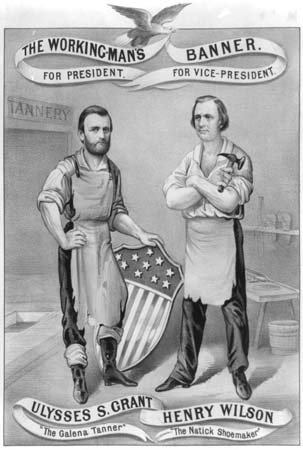
 Johnson's angry charges brought an open break between the two men and strengthened Grant's ties to the Republican Party, which led to his nomination for president in 1868. The last line of his letter of acceptance, “Let us have peace,” became the Republican campaign slogan. Grant's Democratic opponent was Horatio Seymour (Seymour, Horatio), former governor of New York. The race was a close one, and Grant's narrow margin of victory in the popular vote (300,000 ballots) may have been attributable to newly enfranchised black voters. The vote of the electoral college was more one-sided, with Grant garnering 214 votes, compared with 80 for Seymour. (See primary resource document: First Inaugural Address (Ulysses S. Grant: First Inaugural Address).)
Johnson's angry charges brought an open break between the two men and strengthened Grant's ties to the Republican Party, which led to his nomination for president in 1868. The last line of his letter of acceptance, “Let us have peace,” became the Republican campaign slogan. Grant's Democratic opponent was Horatio Seymour (Seymour, Horatio), former governor of New York. The race was a close one, and Grant's narrow margin of victory in the popular vote (300,000 ballots) may have been attributable to newly enfranchised black voters. The vote of the electoral college was more one-sided, with Grant garnering 214 votes, compared with 80 for Seymour. (See primary resource document: First Inaugural Address (Ulysses S. Grant: First Inaugural Address).)Grant's presidency
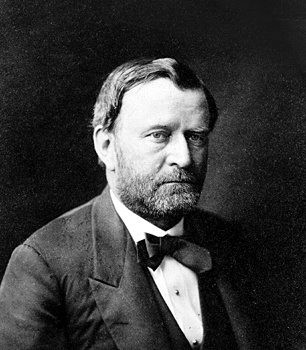 Grant entered the White House on March 4, 1869, politically inexperienced and, at age 46, the youngest man theretofore elected president. His appointments to office were uneven in quality but sometimes refreshing. Notably, Grant named Ely S. Parker, a Seneca Indian who had served with him as a staff officer, commissioner of Indian affairs, and Grant's wife persuaded him to appoint Hamilton Fish secretary of state. Strong-willed and forthright, Julia Grant (Grant, Julia) also later claimed credit for helping to persuade her husband to veto the Finance Bill, but she did not often involve herself in presidential decisions. She daringly—for that time—supported women's rights and considered Susan B. Anthony (Anthony, Susan B.) to be a friend. As a result, it is said, Anthony supported Grant when he ran for reelection in 1872, rather than the first woman candidate for the presidency, Victoria Claflin Woodhull (Woodhull, Victoria) of the Equal Rights Party, a splinter group that had bolted from the National Woman Suffrage Association convention.
Grant entered the White House on March 4, 1869, politically inexperienced and, at age 46, the youngest man theretofore elected president. His appointments to office were uneven in quality but sometimes refreshing. Notably, Grant named Ely S. Parker, a Seneca Indian who had served with him as a staff officer, commissioner of Indian affairs, and Grant's wife persuaded him to appoint Hamilton Fish secretary of state. Strong-willed and forthright, Julia Grant (Grant, Julia) also later claimed credit for helping to persuade her husband to veto the Finance Bill, but she did not often involve herself in presidential decisions. She daringly—for that time—supported women's rights and considered Susan B. Anthony (Anthony, Susan B.) to be a friend. As a result, it is said, Anthony supported Grant when he ran for reelection in 1872, rather than the first woman candidate for the presidency, Victoria Claflin Woodhull (Woodhull, Victoria) of the Equal Rights Party, a splinter group that had bolted from the National Woman Suffrage Association convention.Julia was not beautiful—she had a cast in her left eye and squinted—but Grant was attracted to her liveliness, and his devotion to her was unbounded. Photography was just becoming part of the political scene when Julia rose to prominence as first lady, and, self-conscious about her looks, she contemplated having surgery to correct her eyes. Grant vetoed the idea, saying he loved her as she was. Consequently, almost all pictures of her were taken in profile.
The Grants had four children. Their daughter, Nellie, became a national darling, and when she was married in the White House in 1874, the public was entranced by the details of the wedding. The executive mansion was also the home for both the president's father and his father-in-law, whose squabbling with each other was general knowledge and aroused considerable public amusement. Because the Gilded Age was at hand, Americans did not seem to mind that the Grants enjoyed ostentatious living. They redecorated the White House lavishly and entertained accordingly, with state dinners sometimes consisting of 29 courses complemented by nine French wines.
On March 18, 1869, Grant signed his first law, pledging to redeem in gold the greenback currency issued during the Civil War, thus placing himself with the financial conservatives of the day. He appointed the first Civil Service Commission, but after initially backing its recommendations, he abandoned his support for the group when faced with congressional intransigence. Grant was more persistent but equally unsuccessful when the Senate narrowly rejected a treaty of annexation with the Dominican Republic (which Grant had been persuaded would be of strategic importance to the building of a canal connecting the Atlantic and Pacific oceans). His negotiation of the Treaty of Washington provided for the settlement by international tribunal of American claims against Great Britain arising from the wartime activities of the British-built Confederate raider Alabama (Alabama claims), whose sale had violated Britain's declared neutrality.

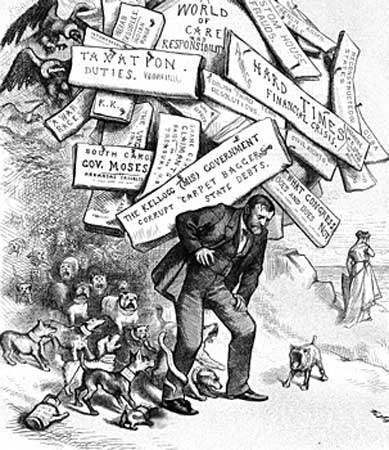
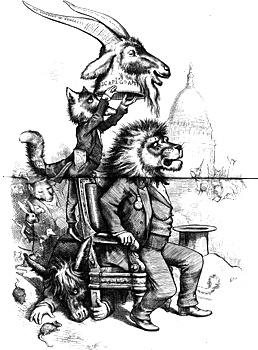
 Grant won reelection easily in 1872, defeating Horace Greeley (Greeley, Horace), the editor of the New York Tribune and the candidate for the coalition formed by Democrats and Liberal Republicans, by nearly 800,000 votes in the popular election and capturing 286 of 366 electoral votes. (See primary source document: Second Inaugural Address (Ulysses S. Grant: Second Inaugural Address).) During the campaign, newspapers discovered that prominent Republican politicians were involved in the Crédit Mobilier (Crédit Mobilier Scandal) of America, a shady corporation designed to siphon profits of the Union Pacific Railroad. More scandal followed in 1875, when Secretary of the Treasury Benjamin Helm Bristow (Bristow, Benjamin Helm) exposed the operation of the “ Whiskey Ring,” which had the aid of high-placed officials in defrauding the government of tax revenues. When the evidence touched the president's private secretary, Orville E. Babcock, Grant regretted his earlier statement, “Let no guilty man escape.” Grant blundered in accepting the hurried resignation of Secretary of War William W. Belknap, who was impeached on charges of accepting bribes; because he was no longer a government official, Belknap escaped conviction. Discouraged and sickened, Grant closed his second term by assuring Congress, “Failures have been errors of judgment, not of intent.”
Grant won reelection easily in 1872, defeating Horace Greeley (Greeley, Horace), the editor of the New York Tribune and the candidate for the coalition formed by Democrats and Liberal Republicans, by nearly 800,000 votes in the popular election and capturing 286 of 366 electoral votes. (See primary source document: Second Inaugural Address (Ulysses S. Grant: Second Inaugural Address).) During the campaign, newspapers discovered that prominent Republican politicians were involved in the Crédit Mobilier (Crédit Mobilier Scandal) of America, a shady corporation designed to siphon profits of the Union Pacific Railroad. More scandal followed in 1875, when Secretary of the Treasury Benjamin Helm Bristow (Bristow, Benjamin Helm) exposed the operation of the “ Whiskey Ring,” which had the aid of high-placed officials in defrauding the government of tax revenues. When the evidence touched the president's private secretary, Orville E. Babcock, Grant regretted his earlier statement, “Let no guilty man escape.” Grant blundered in accepting the hurried resignation of Secretary of War William W. Belknap, who was impeached on charges of accepting bribes; because he was no longer a government official, Belknap escaped conviction. Discouraged and sickened, Grant closed his second term by assuring Congress, “Failures have been errors of judgment, not of intent.”Scandals have become the best-remembered feature of the Grant administration, obscuring its more positive aspects. Grant supported both amnesty for Confederate leaders and civil rights for former slaves. He worked for ratification of the Fifteenth Amendment and went to Capitol Hill to win passage of the Ku Klux Klan Act (Force Acts) of 1871, although he was largely ineffective in enforcing the civil rights laws and other tenets of Reconstruction. His 1874 veto of a bill to increase the amount of legal tender diminished the currency crisis during the next quarter century, and he received praise two years later for his graceful handling of the controversial election of 1876, when both Republican Rutherford B. Hayes (Hayes, Rutherford B.) and Democrat Samuel Jones Tilden (Tilden, Samuel J) claimed election to the presidency.
Later life
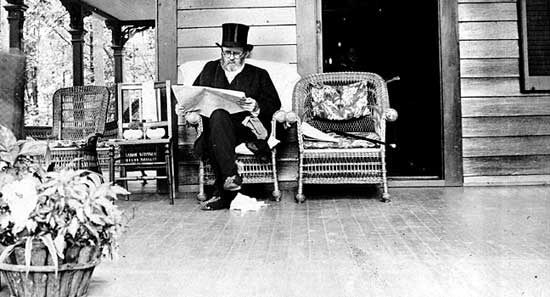 After leaving office, Ulysses and Julia Grant set forth on a round-the-world trip in May 1877. Grant's reputation as the man who had saved the American Union having preceded him, he was greeted everywhere as a conquering hero. In Great Britain he and his wife were feted by Queen Victoria at Windsor Castle; they also met Benjamin Disraeli (Disraeli, Benjamin, Earl Of Beaconsfield, Viscount Hughenden Of Hughenden). In Germany they were greeted by Otto von Bismarck (Bismarck, Otto von); and in Japan they shook hands with the emperor. Americans were delighted with these reports from overseas. The Grants themselves were left pondering their good fortune.
After leaving office, Ulysses and Julia Grant set forth on a round-the-world trip in May 1877. Grant's reputation as the man who had saved the American Union having preceded him, he was greeted everywhere as a conquering hero. In Great Britain he and his wife were feted by Queen Victoria at Windsor Castle; they also met Benjamin Disraeli (Disraeli, Benjamin, Earl Of Beaconsfield, Viscount Hughenden Of Hughenden). In Germany they were greeted by Otto von Bismarck (Bismarck, Otto von); and in Japan they shook hands with the emperor. Americans were delighted with these reports from overseas. The Grants themselves were left pondering their good fortune.In 1879 Grant found that a faction of the Republican Party was eager to nominate him for a third term. Although he did nothing to encourage support, he received more than 300 votes in each of the 36 ballots of the 1880 convention, which finally nominated James A. Garfield (Garfield, James A.). In 1881 Grant bought a house in New York City and began to take an interest in the investment firm of Grant and Ward, in which his son Ulysses, Jr., was a partner. Grant put his capital at the disposal of the firm and encouraged others to follow. In 1884 the firm collapsed, swindled by Ferdinand Ward. This impoverished the entire Grant family and tarnished Grant's reputation.
In 1884 Grant began to write reminiscences of his campaigns for the Century Magazine and found this work so congenial that he began his memoirs. Despite excruciating throat pain, later diagnosed as cancer, he signed a contract with his friend Mark Twain (Twain, Mark) to publish the memoirs and resolved grimly to complete them before he died. (For an account of Grant's experience writing his memoirs, seemPersonal Memoirs.) In June 1885 the Grant family moved to a cottage in Mount McGregor, New York, in the Adirondack Mountains, and a month later Grant died there. A funeral cortege seven miles long accompanied his coffin to a temporary vault in New York City's Riverside Park. In 1897, on the 75th anniversary of his birth, his remains were removed to a magnificent neoclassical granite tomb at Riverside Drive on Morningside Heights in Manhattan. The project, supervised by the Grant Monument Association, was paid for by almost 100,000 contributions. A million people turned out for the dedication proceedings, with President William McKinley (McKinley, William) among the dignitaries in attendance.
Grant's Tomb (General Grant National Memorial), designed by the architect John Duncan, is one of the largest mausoleums in the world, 150 feet (45 metres) high, with a domed rotunda and allegorical relief figures representing episodes in Grant's life. Two figures representing victory and peace support a granite block containing Grant's epitaph, his own words, “Let us have peace.” The centre crypt contains two sarcophagi. Julia Grant, who lived until 1902, was interred beside her husband, as they had planned. It was said that the idea of a single burial place for the both of them stemmed from Grant's visit to the tomb of Ferdinand and Isabella in Spain.
Grant completed his memoirs shortly before his death. Written with modesty and restraint, exhibiting equanimity, candour, and a surprisingly good sense of humour, they retain high rank among military autobiographies.
For an additional writing by Grant, see The Separation of Church and School (Ulysses S. Grant: The Separation of Church and School).
Cabinet of President Ulysses S. Grant
Cabinet of President Ulysses S. Grant Cabinet of President Ulysses S. GrantThe table provides a list of cabinet members in the administration of President Ulysses S. Grant.
Additional Reading
Grant's memoirs and letters are presented in E.B. Long (ed.), Personal Memoirs (1952, reissued 1962). This collection is supplemented by another 175 letters in Memoirs and Selected Letters, 2 vol. in 1 (1990), covering the period 1839–65. There have been many editions of the Memoirs alone, the most recent contains an introduction by James M. McPherson (1999). John Y. Simon (ed.), The Papers of Ulysses S. Grant, 22 vol. (1967–98), compiles an immense number of Grant's letters—most never before published—and other documents beginning with his West Point days. An excellent brief biography is Bruce Catton, U.S. Grant and the American Military Tradition (1954). More detailed studies are available in William B. Hesseltine, Ulysses S. Grant, Politician (1935, reissued 1957); Lloyd Lewis, Captain Sam Grant (1950); Bruce Catton, Grant Moves South (1960, reissued 1988), Grant Takes Command (1969), and A Stillness at Appomattox (1953, reissued 1977); William S. McFeely, Grant (1981); and Gene Smith, Lee and Grant: A Dual Biography (1984). Analyses of Grant as a soldier include J.F.C. Fuller, The Generalship of Ulysses S. Grant, 2nd ed. (1958, reprinted 1977); Allen Nevins, Hamilton Fish: The Inner History of the Grant Administration, 2 vol., revised (1957); T. Harry Williams, Lincoln and His Generals (1952, reprinted 1981); Kenneth P. Williams, Lincoln Finds a General, vol. 3–5 (1952–59); and the appropriate chapter in John Keegan, The Mask of Command (1987). Brooks D. Simpson, Let Us Have Peace: Ulysses S. Grant and the Politics of War and Reconstruction, 1861–1868 (1991), assesses Grant's political development during this period. Four of the latest evaluations are Geoffrey Perret, Ulysses S. Grant: Soldier and President (1997); Harry J. Maihafer, The General and the Journalists: Ulysses S. Grant, Horace Greeley, and Charles Dana (1998); Frank J. Scaturro, Grant Reconsidered (1998); and Brooks D. Simpson, The Reconstruction Presidents (1998). Julia Dent Grant is the subject of Ishbel Ross, The General's Wife: The Life of Mrs. Ulysses S. Grant (1959). John Y. Simon (ed.), The Personal Memoirs of Julia Dent Grant (Mrs. Ulysses S. Grant) (1975, reprinted 1988), is her autobiography, written in the 1890s. Ed.
- Aurignacian culture
- Aurillac
- Auriol, Vincent
- Aurobindo, Śrī
- aurochs
- Aurora
- aurora
- aurresku
- Aurunci
- Aurès
- Aurélien Lugné-Poë
- Auschwitz
- auscultation
- Auseklis
- Ausgleich
- Ausias March
- Auslander, Joseph
- Ausonius, Decimus Magnus
- austausch coefficient
- austenite
- Austen, Jane
- Austerlitz, Battle of
- Auster, Paul
- Austin
- Austin, Alfred